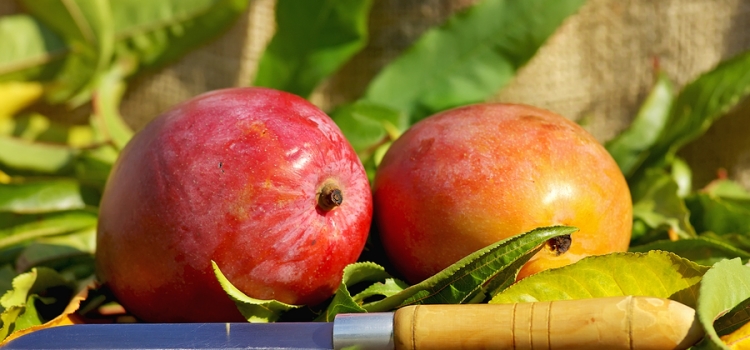Mangoes, also called the king of fruits, are packed with vitamins, minerals, and antioxidants and are sure to help you reach and maintain optimal health.
While mangoes have certainly become more popular in recent years—never before have we seen the sheer number and diversity of mango jellies, jams, pickles, and spices that we have today—they’re an old favorite in many parts of the world. When American kids were growing up with sips of ginger ale to soothe nausea, the stomach-soothing fruit of choice in many countries was (and still is) the mango.

Mangoes are rich in fiber, which works to prevent constipation and other colon troubles. They also serve as a good source of potassium. While regular exercise is absolutely crucial to reaching and maintaining a healthy weight, you do lose bodily potassium with strenuous activity. Though this certainly does not work as an excuse to refrain from exercise, it’s a perfectly good reason to increase your mango intake.
So far, all good news. But if there’s no downside, why is it that so many of us hardly ever get a chance to eat them?
Honestly, it may come down to effort. Bananas and apples are the two most popular fruits in the United States. While they’re perfectly delicious in their own ways, you should also keep in mind that apples and bananas can be thrown into a kid’s lunchbox without a second thought. There’s a misconception that mangoes are too hard to slice and prepare, and that idea may actually be keeping many people from enjoying mangoes as a regular part of their lives.
Let’s start by making something clear: it is not hard to cut a mango. There are, however, many ways to do so. While some people may attempt to “wing it” before feeling discouraged with the results, we recommend that you keep things simple. Read over a few different mango preparation methods, choose one, and stick to it. Within minutes you’ll be a pro, and never again will something as trivial as knife-direction keep you from enjoying this treat.
Standard Method
It’s always easiest to start with the basics. This method of mango slicing is fast and easy.
To start out, find the long axis of your mango.

Make two parallel slices along the sides, on either side of the seed. The seed is in the middle of the mango, and its flat shape should make it easy to leave much of the mango in these two sliced-off cheeks.

One at a time, take each of the two slices in your hand. Hold one in your palm, and with the other hand use a knife to make crisscross slices through the mango flesh. Be careful though—you don’t want to press to hard or the knife might push through the skin to your palm.
Continue holding the mango half in your palm, but take your three middle fingers (index, middle, and ring) and use them to push the fruit inside-out. This will allow the fruit “cubes” to stand up, and you may choose to serve as-is.

An alternative is to cut out these attached cubes, sliding your knife parallel to the skin. This is best done with a curved, serrated knife.
Remember the last bit of mango flesh, the part left surrounding the flat seed? You can get to it by peeling the remaining skin, holding the seed with your fingers or a fork, and eating around the seed like you would corn on the cob.

Sliced Method
The standard method of mango-cutting makes for great presentation, and it’s especially appropriate for those who like bite-sized chunks that can be eaten with a fork. For those who would prefer to enjoy the fruit in long, flat slices (think the shape of apple slices), this method is the way to go.
First, peel your mango. This is best done with a Y-shaped peeler or very sharp paring knife, pulling the skin towards you from top to bottom.

Mango flesh is slippery, so your safest bet is going to be holding the peeled side with a paper towel as you go along. Be sure to peel the top and bottom of the fruit as well. When you finish, find the tallest side of the mango. Slice the mango in half from that line, but be sure not to hit the pit in the center as you go. You’ll have to run your knife parallel to it.

Hold the fruit up vertically or place it on its flattest side, and trim the rest of the fruit off of the pit. Finally, return to your two large halves of flesh and slice into cubes or wedges.

Angled-Cut Method
This may be one of the most straight-forward ways to cut a mango, though it does require a spoon for eating. Here’s how it works:
Start to cut down through the middle of the mango, but don’t—instead, angle over to one side. As you get close to the pit, start to cut around the pit and through to the other side.
Separate the two halves. Then use a spoon to cut the pit out from the half it’s in. Treat each half like a small bowl, and serve yourself bite-sized chunks with the spoon.

Avocado Method
This one is just as fast and easy as slicing an avocado, hence the name. That said, we wouldn’t recommend it to someone who doesn’t have much practice with a chef’s knife. If you don’t know what you’re doing and you aren’t careful, this could be somewhat dangerous and very messy.
Make a cut in the middle, cutting down to the seed or pit. Then twist the mango around so that your cut is made around the entire fruit. You are cutting it in half, but NOT cutting through the seed. Separate the two halves of the mango, so that one half has the entire pit and the other doesn’t.

Take the half with the pit and hold it in your less-dominant hand, with the pit facing up. Using a chef’s knife, firmly strike the pit until the knife sticks.
While holding the mango half still in your less-dominant hand, rotate the knife until the pit falls free. If you’re good with a chef’s knife, this might be the best method for you to commit to practicing until you get it perfect. Once you have this technique down, it’s definitely the fastest and cleanest cut to have in your skill set.
General Tips
Whatever method you choose to use for your next mango purchase, keep in mind that all of these are best done over (or at least close to) the kitchen sink. It can get messy, and you don’t want a sticky counter to keep you from enjoying the fruit. If you don’t plan on eating your mango immediately, be sure to store it in the refrigerator.
There you have it, an end to the excuses! Mangoes have so much to offer nutritionally, and with all the different preparation methods available there’s really no reason to avoid them. Some of these require practice, but a lot of it just depends on knowing what is appropriate for your needs. We recommend starting with something simple, like the standard method or the angled-cut method. Before you know it, it will become second nature!
Editor’s Note:
If you are feeling up to the challenge, this videos demonstrates a very impressive (and surprisingly simple) mango cutting method. Enjoy watching, and give it a try if you want to have something that is both beautiful and delicious!
Pro Tip on Removing Mango Stains:
Put the stained fabric IMMEDIATELY into COLD water and add laundry detergent or stain pre-treater. Work it in well and then rinse with HOT water. If the stain is still there you can try bleach—but make sure to use oxygen-based bleach and, obviously, be careful with colored fabrics, as you don’t want to replace a mango stain with a bleach stain!




When looking at a page, how do I
“go back” to previous page?
Hi, Teressa. The back arrow in your browser is adequate – it won’t mess anything up.
I would love fresh fruit in season but my menus NEVER reflect when or what fruit to eat. This week I got a banana but every other fruit on my menu is dried…….do you know why? I’m baffled!!
Hi, aggioschin. I took a look at your most recent menu, and it appears that you have all fresh fruit now. If you are still having tech difficulties, Customer Service would be happy to help – you can reach them directly through the “Contact Us” link below.